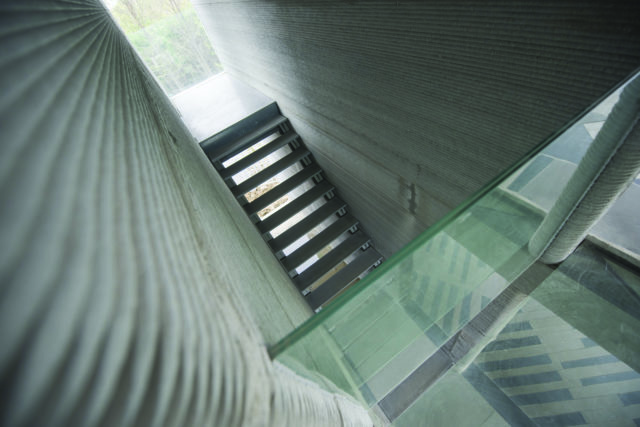
The U.S. is facing a national housing supply shortage. According to some estimates, the country needs more than 3.5 million more houses in order to meet soaring demand—at a time when materials, shipping and construction costs are higher than they’ve ever been. Concurrently, climate change is encroaching from all sides and without a means to reduce the massive environmental footprint that construction creates, the U.S. is stuck between a rock and a hard place.
Luckily, a new project from researchers at Texas A&M University is taking aim at those problems. Using a single, elegant, green technology they believe could help simultaneously reduce the cost of building, curb emissions from construction, and build homes that save energy.
And they’re going to do it all using hemp.
“Hempcrete is a very attractive [material],” Petros Sideris, an assistant professor in Texas A&M’s Zachry Department of Civil and Environmental Engineering, says. “It’s a great opportunity at reducing, or at least changing, the predictions of our environmental footprint.”
Sideris is leading a team of researchers at Texas A&M studying the potential for 3D printing houses made out of hemp-concrete (or hempcrete). While the project hasn’t officially started yet, the researchers see a lot of potential in this idea; using printed hempcrete buildings to combat some of the most serious problems facing our society. And the U.S. government evidently sees a lot of potential in it too. This specific project was recently awarded a $3.8 million grant by the U.S. Department of Energy’s Harnessing Emissions into Structures Taking Inputs from the Atmosphere (HESTIA) program.
If that seems like a contrived abbreviation, that’s because it is. Hestia was the Greek goddess of “hearth” or “fireside,” and the Department of Energy’s HESTIA program aims to develop “building materials and whole-building designs from a wide range of potential feedstocks … that are net carbon negative on a life-cycle basis by using atmospheric CO2 in the production process.”
In Sidris’ case at A&M, the feedstock they’re using is industrial hemp stalks, which grow out of the ground and can absorb up to 15 tonnes of CO2 per hectare (which is a more efficient carbon sink than agro-forestry). Concrete, on the other hand, is made by firing limestone, clay, and other materials in a kiln and produces roughly .9 pounds of CO2 for every pound made. To put that differential in perspective: 30 billion tons of concrete is used annually around the world. If that math abides, that’s 54 trillion pounds of CO2 emitted for global concrete production every year.
Hempcrete is made using powdered hemp, hemp hurds (pulverized stalks), lime, sand and water and mixing it into a slurry. Sideris’ research project will combine that with 3D-printing technology that will print the walls of the structure one horizontal layer at a time, Sideris explains.
He admits he’s not the first to come up with the idea of using a 3D printer to print homes or buildings. Others have done it before, just using regular concrete mixes. However, Sideris’ team will be the first to test how that same technology works using hempcrete instead.
“The very exciting thing about 3D printing as a process is it’s quite environmentally friendly because when you look at traditional construction it means a lot of waste,” Sideris says. The concrete comes in big boxes, on pallets, and a lot of it gets wasted using traditional concrete pouring methods. By comparison, a 3D printer is extremely exact.
“It’s very neat,” he says. “You place concrete only at the locations where you need to.”
On top of that, preliminary tests have shown that hempcrete is very fire resistant, water resistant, impervious to mold and insect damage, has significant sound damping acoustic properties, and has extremely good thermal insulation properties. That means that in the summertime hempcrete structures will stay cool, and in the winter they’ll hold warmth, saving energy on air conditioning and heating (and saving homeowners money).
It does have drawbacks, Sideris admits. Hempcrete isn’t as strong as regular concrete, and so it will require additional materials like steel or wood for internal framing to increase structural integrity. It’s also significantly more expensive. According to Colleen Keahey Lanier, executive director of the Hemp Industries Association, at current prices it could add up to $100,000 to the cost of building a house, depending on its size.
“Generally, whatever the standard price is for build-per-square-foot, add a minimum of $60 to that,” Lanier told Realtor.com. “So where it may cost an average of $120 per square foot on a traditional build, a hempcrete structure may cost $180 per square foot or more.”
For now, however, Sideris is hopeful that cost will come down with time.
“At this point the material is on the expensive side,” he says. “[But it’s] expensive because there is no industry to use it [yet].”
As with any new technology or material, cost is high at the onset and decreases as people adopt it on a wide enough scale. And because 3D printed hempcrete sits at the intersection of sustainability and resilience, Sideris thinks it’s worth getting excited about.
“[This] is a step in the right direction of building resiliently and sustainably at the same time,” he says. “I think it has great potential. That’s why we’re all very excited.”
***
Email: [email protected]














